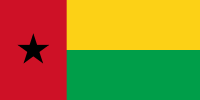Flag of Guinea-Bissau
| Flag of Guinea-Bissau | |
|---|---|
 |
|
| Vexillological symbol : |
|
| Aspect ratio: | 1: 2 |
| Officially accepted: | September 24, 1973 |
The flag of Guinea-Bissau was officially introduced on September 24, 1973.
meaning
The colors have the following meanings:
- The red stripe is a reminder of the work, struggle and suffering that the people endured during the colonial era. In addition, the red stands for the war that the people waged to achieve independence.
- Yellow symbolizes the fruits of labor and the harvest, which ensures well-being.
- Green stands for tropical nature and the hope for a happy future.
- The black five-pointed star is a symbol of Africa and its black people and their dignity, freedom and peace.
The resemblance to the earlier flag of Cape Verde was deliberately chosen and expressed the unification efforts with this state.
history
Only the flag of Portugal was used in Portuguese Guinea during the colonial period . In 1967 there was a proposal to add the respective coat of arms of the colony to the flag of Portugal for the colonies . However, the proposal was not implemented.
The national flag of Guinea-Bissau emerged from the flag of the independence movement PAIGC ( Partido Africano da Independência da Guiné e Cabo Verde ), which used the pan-African colors red-yellow-green. After independence was achieved in 1973, the PAIGC lettering under the black star was removed - this gave the flag its current appearance.
literature
- Whitney Smith , Ottfried Neubecker : The signs of people and peoples. Our world in flags and banners. Reich Verlag, Lucerne 1975, ISBN 3-7243-0115-4




